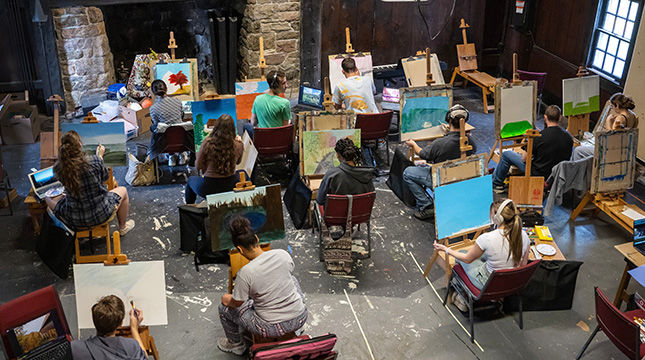The space that served as Mary Behrend’s art studio is a center of art instruction once again.
The “small barn” located in front of the Glenhill Farmhouse at Penn State Behrend has been many things: a bunkhouse, a farmer’s office, a student lounge, a library, a classroom, and a theater. The building was part of the original estate that Ernst and Mary Behrend purchased for their country getaway.
The Behrends turned the barn into a cottage, adding a stone foundation, a large fireplace and chimney, a transom, windows, a staircase, a bathroom, and a “sleeping bunk” that provided guest lodging in the 1930s. Mary occasionally used the space to entertain her friends.
In later years, before Mary donated the property in 1948, creating what is today Penn State Behrend, the little cottage became Mary’s art studio, a cherished, quiet place for her to paint. She mostly painted landscapes, often scenes from her Glenhill farm.
Mary took her hobby seriously. She learned from one of the best: Famed Erie artist Joseph Plavcan was her painting tutor. The two worked together at Mary’s studio, where, in 1945, Plavcan left a sketch of Mrs. Behrend in a guestbook.
It’s a scene that could be recreated today, eighty years later, with one of the dozens of Behrend students who are, once again, painting and drawing in Mary’s studio.
A Welcome Move
When Dan Schank, associate teaching professor of art, learned his art classes would be moving to the studio, he was excited. The studio offered more space, which meant more students could take an art elective. It’s also a more inspiring place to be creative.
“It’s such a great building with its deep, dark wood structure and stone accents,” Schank said. “It has a long, rich history, and I think students benefit from making art in a place with such an eclectic flavor.”
There is no mistaking the purpose of the studio today.
Brushes fill buckets in the back of the room. Tubes of paint and cans of fixer clutter a portable cart. Canvases are propped against the old wooden walls to dry while watercolor paintings are laid flat in a wire rack in the entryway.
Students fill the art stools spread out on the paint-splattered floor, their work in various stages of completion in front of them. Schank wanders among them, fielding questions and offering observations, suggestions, and compliments.
Taking Big Creative Swings
While Behrend is largely known for its strong STEM presence, Schank says there’s great value in including the arts and humanities as well.
“Courses like Intro to Painting or Intro to Drawing encourage students to use a different mental skill set than many of them are used to,” he said. “I teach them to rely on intuition, something that contrasts sharply with the part of their brain that is constantly fact-checking or measuring. There are no right answers here, and by working more instinctively, they develop a new way to observe the world.”
Schank has noticed clear connections to many disciplines at Behrend that may not be thought of as creative in a traditional sense.
“A lot of our engineering majors are natural ‘tinkerers,’” he said. “They like pulling things apart, seeing how they work, and putting them back together again. There’s a trial-and-error quality to artmaking that utilizes this instinct very effectively and allows them to do so in a safe, low-risk setting. They can take big creative swings without having to get it perfectly right.”
Practice = Improvement
Schank, who has been teaching art for decades, equates artistic talent to athletic achievements.
“A lot of art instruction, especially at the introductory level, is like learning a sport,” he said. “Some people are naturally stronger or faster than others, but everyone can improve with enough practice.”
When students struggle in an art class, Schank said, they tend to take it more personally than if they’d done poorly on a science or English exam.
“But I don’t think the processes are all that different,” he said. “If you put the time in, you can achieve the end goal that you desire. You just have to keep working on it.”
There’s no doubt Mary Behrend and Joseph Plavcan, the Behrend art studio’s original student and teacher, would agree. They spent many hours putting paint on canvas in the very space Behrend students are learning in again today.
